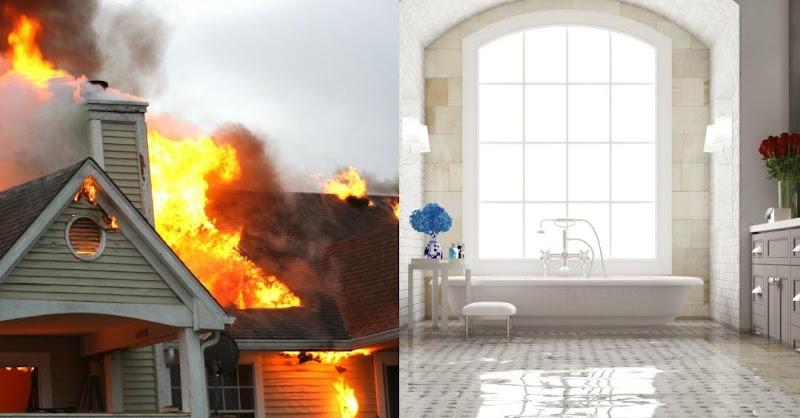Reportedly, there is a significant destructive impact of water damage on homes. Water damage causes serious hazards involving structural issues and fungal growth, which ultimately can be dangerous to health. In addition to this, it is not only confined to the affected area but also proliferates in surrounding areas. Water damage may cause the whole wall or some part of it to collapse or even ruin the roof, which requires thousands of dollars for repair.
It is not unusual, as approximately 14,000 US citizens observe numerous types of water damage in their surroundings, either in their own homes or anywhere else; hence, the need to understand what water damage is, its causes, and its solutions becomes crucial.
Absolutely, let’s start our exploration.
What is Water Damage? 6 Potential Kinds of Water Damage
Water damage refers to the leakage of water in its surroundings or the expansion of moisture in the adjacent areas. This can be of various types like drainage from any plumbing source or problems with the savage water like leaking duct etc.
Following are the six main reasons causing water damage:
- Widespread permeation of water from external sources, affecting massive property damage;
- Bursting or leaking of pipes within the homes resulting in water damage;
- A damaged roof can also cause leakage and seepage damaging the interior;
- Faulty appliances are also reason for water damage for instance refrigerators, washing machines, or dishwashers;
- Accumulation of water in the basement, mostly attributed to inadequate drainage or often due to poor drainage or intense rainfall;
- And lastly, failure of the sewage system causes penetration of contaminated water in the homes.
So, by any chance, if you are suspicious regarding any of the above mentioned issues in your house then before any further risk feel free to contact
Nashville Roofers, MidSouth Construction now. The experts of our team will figure out the probable water damages that may occur and also they will mend it. Besides this, we are also capable of providing preventive measures to avoid this in the future.
How to Assess & Repair Water Damage? 4 Key Steps to Take
Repairing water damage is a quite forthright procedure. However, we have made it stress-free for you. Now you have two choices:
- Consult professionals for assistance like Nashville Roofers & Restoration experts MidSouth Construction;
- Or perform some DIY endeavour with our support.
So, if you’re inclining toward the second option, we made it even easier for you to understand by dividing the repairing method into four easy steps that will ensure the assessment and repair of water damage.
1: Identify Damaged Areas
The most crucial step is to identify the water damage area. Though the first thing indicating the water damage is the foul odor near the damaged area the bad smell is mostly due to the molds (fungus) in that area. A stronger smell indicates the closer proximity to the damage.
However, here are 5 tips to help you find and assess the damaged areas quickly:
- Check for peeling or bubbling paint;
- Observe staining on ceilings and walls (or even sometimes on materials as well);
- Examine stale or stuffy aromas, as they indicate fungal growth;
- Inspect distorted or drooping floors.
The aforementioned are the quickest ways to detect water damage or you may always call MidSouth Construction the experts to discover it for you.
2: Remove and Replace
The following step involves focusing on and replacing the main cause of the problem. This step is entirely based on the specific type of damage that occurred for example if there is a loose fitting in the valve then it is required to be well-fitted or if the pipe is leaked or damaged it needs to be sealed or a new pipeline accordingly.
Nonetheless, the following are four steps to identify the issue, and then remove and replace it:
- Utilize pumps to remove water, followed by dehumidification to prevent mold growth
- Eradicate broken materials like flooring, insulation, or drywall
- For the prevention of mold formation apply an antimicrobial solution on the affected area
- Swap damaged materials and ensure appropriate ventilation for prevention
Following the cleanup, there’s still more work to be done, so proceed to the next step.
3: Repair Structural Elements
This phase is based on mending the adjacent areas damaged by water. For example, walls might require a change of wood or other structural elements whereas roofing might require new shingles and sealants. Here are three guidelines to fix this:
- Strengthen damaged areas with proper techniques and building materials;
- Evaluate structural integrity to identify and address any weaknesses;
- And make sure appropriate waterproofing and sealing to avoid future water damage.
This must guarantee that nothing remains affected by water damage.
4: Prevent Future Leaks
To ensure no further water damage in the future one should keep in mind that faulty water appliances are not the only reason for causing water leakage issues. That’s the reason one should take the following precautionary methods:
- Provide adequate ventilation and airflow;
- Frequently check and maintain drainage channels;
- Efficiently seal doors and windows;
- Swiftly supervise and mend plumbing leaks;
- Lastly, mount a sump pump if required.
By following these steps you’ll be relieved otherwise you can always give us a call at MidSouth Construction for the provision of preventative measurements to avoid future problems.
Conclusion
Comprehending some of the crucial viewpoints will make it easier to understand the water damage in homes that homeowners can also fix. Implementing the suggested repair techniques along with concentrating on the affected areas would be helpful in resolving the problem. If you doubt yourself and are ambiguous about where to begin, don’t hesitate to reach out to MidSouth Construction today; we’ll handle it all for you.

